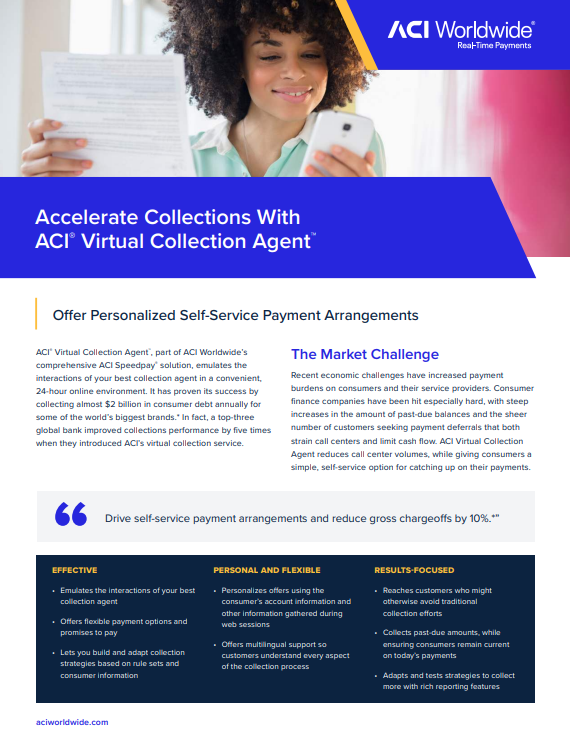Industry Guide
Understanding debt collection and recovery
Debt collection doesn’t have to be difficult with the right technology; you can optimize recovery efforts while preserving customer relationships
On This Page
What is debt collection?
Debt collection is the process of recovering money that is owed by individuals or businesses. It typically begins when a customer misses one or more payments. The creditor can collect the debt directly or hire a third-party collection agency.
Debt collectors employ multiple channels to contact debtors, such as telephone calls, email correspondence, written letters, and text messaging. They may also offer payment plans or negotiate settlements to help resolve the debt. In some cases, legal action may be taken to recover the money. Many businesses now rely on technology such as debt collection software and virtual agents to automate outreach, track payments, and streamline communication, making collections more efficient for all parties.
Today’s debt collection tools are designed to be more customer-friendly, making the process faster and smarter. Many companies now use cloud-based software that automates outreach, tracks payments activity, and provides real-time insights into account status. Virtual collection agents, powered by AI, can handle routine communications, reminders, and payment confirmations, freeing up human agents for more complex cases. These technologies lower costs, boost recovery rates, and enhance customer experience, offering flexible self-service through digital channels.
What are some common examples of debt?
Debt can come from many sources. Here are some of the most common types:

Why is timely debt collection essential?
Timely debt collection is critical for organizations aiming to maintain financial health and operational efficiency. Recovering debts promptly offers several key benefits:
- Enhances financial stability: Consistent, on-time payments help maintain steady cash flow, enabling organizations to manage operating expenses, meet financial obligations, and invest in growth opportunities
- Supports healthy working capital: Timely collections ensure sufficient working capital is available to cover daily operations, purchase inventory, and address unexpected costs
- Mitigates financial risk: Prompt debt recovery reduces exposure to cash flow shortages, borrowing costs, credit risks, potential credit rating downgrades, and operational disruptions
- Boosts profitability: Delayed collections require additional staffing and financial resources, diverting them from core business activities. Moreover, the longer a debt remains unpaid, the lower the likelihood of full recovery, directly impacting the bottom line
- Preserves customer relationships: Contrary to common belief, addressing outstanding debts promptly and professionally is less likely to damage customer relationships than prolonged or aggressive collection efforts. Effective debt management also allows businesses to offer more favorable credit terms, fostering customer loyalty and attracting new clients

- Builds credibility and trust: A reputation for ethical and efficient debt collection enhances trust among customers, partners, and stakeholders, reinforcing the organization’s professionalism in financial matters
What challenges do companies typically face around debt collection?
As vital as it is to successful business operations and profitability, debt collection and recovery can also be incredibly challenging. Here are just a few reasons why:
Regulatory complexity
Debt collectors, whether they’re part of an organization’s internal collections team or a third-party agency, are subject to strict regulations under the Fair Debt Collection Practices Act (FDCPA) and the Consumer Financial Protection Bureau’s (CFPB) Debt Collection Rule. These rules prohibit harassment, threats, and deceptive practices when attempting to recover payments.
Under the updated Debt Collection Rule, collectors must provide clear and accurate validation information, including:
- The exact amount owed
- The identity of the creditor
- Breakdown of the debt using an itemized table
- Notification of the consumer’s right to dispute the debt
Additionally, the rule now includes guidance on electronic communications, such as texts and emails, and clarifies restrictions on contacting consumers at unusual or inconvenient times or places. Failure to comply with these regulations can result in serious consequences, including:
- Regulatory enforcement actions
- Individual or class-action lawsuits
- Loss of licensing
- Significant reputational damage

Consumer communications
Under the Fair Debt Collection Practices Act (FDCPA) and its implementing regulation, Regulation F, consumers retain the right to dispute a debt in writing. Once a written dispute is received, whether by mail, email, website portal, or other accepted electronic means, the debt collector must cease all collection activities until they verify the debt or the name and address of the original creditor.
Dispute resolution
This dispute process can extend the timeline for debt resolution, potentially increasing operational costs and, in some cases, leading to litigation or arbitration. The updated rule also clarifies that authorized representatives of deceased consumers may exercise these rights on their behalf.1
Data management
Most businesses handle significant quantities of data, including customer payment and account information, which are used to track ownership and relevant details. As compliance requirements under regulations such as the FDCPA and the CFPB’s Debt Collection Rule become increasingly complex, it is important to maintain accurate, well-organized, and current data.
Efficient debt collection processes depend on the ability to quickly validate debts, respond to disputes, and communicate through approved channels. However, achieving this level of data integrity is often easier said than done, especially when dealing with fragmented systems, legacy platforms, or inconsistent data entry practices.
Economic conditions
Economic uncertainty, including recent downturns and inflationary pressures, continues to impact consumers’ ability to repay debts. As defaults rise, businesses face increased complexity in managing collections while maintaining compliance and customer trust. In response, many organizations are adopting more empathetic and flexible approaches, such as offering customized repayment plans, temporary forbearance, or digital self-service options that allow consumers to manage their obligations more easily.
These strategies not only help preserve customer relationships but also support a company’s reputation and regulatory standing, especially as oversight from agencies like the CFPB emphasizes fair treatment and transparency in debt collection practices.
What is debt collection software?
Debt collection software refers to digital platforms designed to help businesses streamline, automate, and optimize the process of tracking, managing, and recovering outstanding debts. In 2025, these tools evolved beyond basic account management to become strategic assets that improve recovery rates, ensure compliance, and enhance customer experience. While features vary by provider, modern debt collection software typically includes:
- Automated workflows for sending payment reminders, follow-ups, and escalations across multiple channels (SMS, email, voice), reducing manual effort and improving consistency. Many platforms now support customizable messaging aligned with brand tone and regulatory requirements
- Centralized data management with real-time access to debtor profiles, payments history, documents, and communication logs. Advanced platforms prioritize accounts more effectively, offering real-time tracking and credit risk insights
- AI-powered analytics and predictive segmentation, which forecast repayment likelihood, identify high-risk accounts, and recommend tailored recovery strategies. This enables teams to act with both precision and empathy, offering flexible plans to those showing intent to pay
- Self-service payment portals with integrated processing allow debtors to make payments securely and conveniently. These portals offer mobile-friendly interfaces and chat support, increasing engagement and on-time payments2
- Dynamic compliance engines that automatically adjust outreach rules, call caps, and consent protocols based on evolving federal and state regulations (e.g., Reg F, Washington’s 3-in-7 rule). This reduces legal risk and ensures up-to-date practices without manual intervention
- Embedded training and coaching tools for collectors, including real-time call scoring, contextual tips, and micro-learning modules—all designed to improve agent performance and compliance adherence
- Drag-and-drop configurability, allowing teams to build or adjust workflows, templates, and client-specific strategies without needing developer support
Sources:
1Best Debt Collection Software for 2025
2The 2025 buyer’s guide to debt
Is it better for companies to use automated debt collection software or to work with a collections agency?
There’s no easy answer to this question, as every business’s needs vary; what makes sense for one company might not for another. With that said, any company that currently maintains a team of collection agents but is contemplating outsourcing debt collection and recovery to a third-party agency in the hopes of increasing efficiency and scalability may first want to consider debt collection software.
Debt collection software, such as ACI Virtual Collection Agent, enables companies to supplement—or even completely replace—their collections team with automated workflows that can be tailored according to consumer and business needs. In many cases, debt collection software offers organizations more flexibility, visibility, and control over the collections process than working with a third-party agency, enabling them to achieve better results.
In addition to using debt collection software, what other strategies can businesses use to improve their debt collection?
Businesses can enhance their recovery efforts by adopting a compliance-first, consumer-focused strategy. Here are several ways companies can strengthen their approach in 2025:
- Leverage predictive analytics and AI to identify accounts at risk of default and prioritize outreach based on the likelihood of repayment
- Communicate transparently and proactively, using plain language and multiple channels (email, SMS, portals) to notify consumers about upcoming payments and their rights under the FDCPA and Regulation F1
- Take a customer-centric approach by tailoring repayment plans to individual financial circumstances, especially during periods of economic hardship
- Train collections teams to handle sensitive situations with empathy, professionalism, and awareness of updated compliance requirements
- Offer flexible payment options, including digital wallets, installment plans, and income-based repayment structures
- Provide self-service tools that allow consumers to view account details, dispute debts, and make payments securely online
- Document all consumer interactions to ensure compliance, support dispute resolution, and monitor repayment progress
- Establish a streamlined dispute resolution process, aligned with Regulation F’s requirements for timely and accurate debt verification
Source: 1CFPB

How does ACI Worldwide support on-time debt collection?
ACI Virtual Collection Agent—part of the comprehensive ACI Speedpay solution—emulates the interactions of your best collection agent in a convenient 24-hour online environment.
From a strategy manager that enables you to build customized collection strategies based on rule sets and consumer information to rich reporting that helps maximize offer acceptance rates, ACI Virtual Collection Agent reduces stress for your consumers while increasing the overall consistency and efficiency of your debt collection process.
Additional resources:
ACI Speedpay Pulse Report
Why self-serve payment channels are a must-have for modern lenders and billers

Learn how ACI Virtual Collection Agent collects almost $2 billion in consumer debt annually for some of the world’s biggest brands
Download our info sheet or schedule a consultation with a member of the ACI team today.